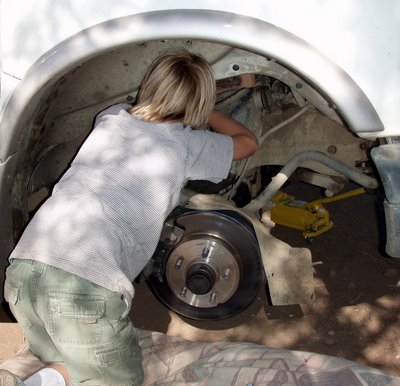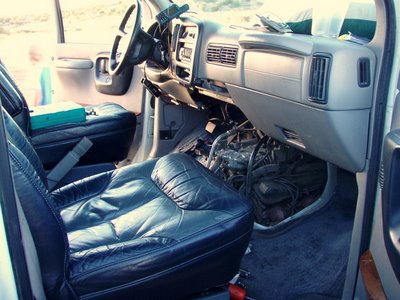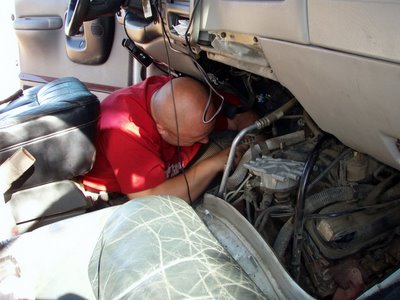Arizona, and also, cheesesteak.
So, here we are, out in the Arizona Desert, with the van half apart. We've got a really bad miss in a couple of the cylinders, and are working on getting it sorted out. Hopefully it will turn out to be ignition related (cheap) not fuel injection related (expensive). We will soon know - wish us luck.
Update:
So far so good - looks like ignition, as it seems to be running fine now with new plugs, cap, rotor, and wires. (knock on wood) To make this more fun, I should remind our kind readers that the vehicle in question is a van, which makes servicing it really entertaining. To get to the sparkplugs, the wheel and fenderliner must be removed. To get to the distributor requires 1/2 hour of interior disassembly, and even then a contortionists merit badge would be a great asset. On top of this, Ive been really sick last night and today, 103+ fever, etc. And did I mention that last night a pipe broke in the trailer and pumped much of our already dwindling supply all over everything? Well, its been fun, to say the least, but laura helps me to keep things in perspective, by reminding me that this is excellent preparation for our high seas adventure. Unfortunately, if memory serves, she's right on about that one. C'est la vie.
 The other six plugs were reached through the wheel well. Blayde and Valin were big helps, both of them removing and replacing most of the plugs themselves.
The other six plugs were reached through the wheel well. Blayde and Valin were big helps, both of them removing and replacing most of the plugs themselves.
On another note... why is it that the only decent cheesesteak sandwich I can find is in Fairbanks, Alaska? Chad bought be dinner at the Oasis there in Fairbanks when I came through on my seven hour tour last month, and I got a big, juicy, yummy, dripping with goopy goodness cheesesteak -thank you Chad. It was in stark contrast to what I get when I order one down here, usually some half dry steak strips and a bit of melted cheese with some bell peppers. What is it with Fairbanks and cheesesteaks? Was it Big Bob of pre- Food Factory fame that did it in the early eighties? if anyone can help me crack the riddle, let me know.
So there we were in the middle of the Arizona desert surrounded by beautiful red rock formations, incredible weather, and a town for parts only 8 miles away. With the impending doom and dread of doing the fuel injectors (3 days work) ahead of us... Tamer and I are sitting in the dark van discussing our various options, and I ask, "Can spark plug wires go bad just a couple at a time"? Hmmmm..... What we discovered after turning off all the interior lights with the console removed to expose the engine, was............... If after starting the engine, there are lots and lots of little dancing lights along both sides of the motor, you MAY need new spark plug wires!!!
Update:
So far so good - looks like ignition, as it seems to be running fine now with new plugs, cap, rotor, and wires. (knock on wood) To make this more fun, I should remind our kind readers that the vehicle in question is a van, which makes servicing it really entertaining. To get to the sparkplugs, the wheel and fenderliner must be removed. To get to the distributor requires 1/2 hour of interior disassembly, and even then a contortionists merit badge would be a great asset. On top of this, Ive been really sick last night and today, 103+ fever, etc. And did I mention that last night a pipe broke in the trailer and pumped much of our already dwindling supply all over everything? Well, its been fun, to say the least, but laura helps me to keep things in perspective, by reminding me that this is excellent preparation for our high seas adventure. Unfortunately, if memory serves, she's right on about that one. C'est la vie.
 The other six plugs were reached through the wheel well. Blayde and Valin were big helps, both of them removing and replacing most of the plugs themselves.
The other six plugs were reached through the wheel well. Blayde and Valin were big helps, both of them removing and replacing most of the plugs themselves.On another note... why is it that the only decent cheesesteak sandwich I can find is in Fairbanks, Alaska? Chad bought be dinner at the Oasis there in Fairbanks when I came through on my seven hour tour last month, and I got a big, juicy, yummy, dripping with goopy goodness cheesesteak -thank you Chad. It was in stark contrast to what I get when I order one down here, usually some half dry steak strips and a bit of melted cheese with some bell peppers. What is it with Fairbanks and cheesesteaks? Was it Big Bob of pre- Food Factory fame that did it in the early eighties? if anyone can help me crack the riddle, let me know.




0 Comments:
Post a Comment
<< Home